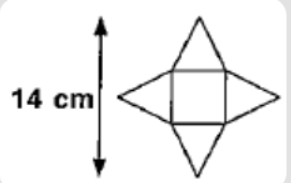
Answer
497.1k+ views
Hint: Find the height of the triangles and use the fact that the area of a triangle $=\dfrac{1}{2}bh$ where b is the base and h is the height and the area of a square $={{a}^{2}}$. There are four triangles and one square. So, the net area will be the sum of 4 times the area of the triangle and area of the square.
Complete step-by-step answer:

Since the length of a side of square = 6cm.
We have AD = 6cm.
Also since the triangles are identical CG = HF
Since the total height of the diagram = 14.
We have CG+AD+HF = 14
i.e. CG+HF+6 = 14
i.e. 2CG+6 = 14
Subtracting 6 from both sides we get
2CG+6-6 = 14-6
i.e. 2CG = 8
Dividing both sides by 2 we get
CG = 4cm
Since CG = HF, we have
HF = 4 cm.
Now we know that the area of a triangle $=\dfrac{1}{2}bh$
Using we get the area of triangle ABC $=\dfrac{1}{2}\times AB\times CG=\dfrac{1}{2}\times 6\times 4=\dfrac{24}{2}=12$
Also, we know that the area of a square $={{a}^{2}}$
Using, we get the area of square ABED $=A{{D}^{2}}={{6}^{2}}=36$.
Hence the total area of the prism = 4 times the area of the triangle ABC + area of square ABED
$=4\times 12+36=48+36=84$
Hence the total area of faces of prism = 84 sq-cm.
Hence option [b] is correct.
Note: Although the figure above is referred to be of a prism, it is a pyramid. A pyramid has triangular faces, whereas a prism has rectangular faces. The diagram above is of a pyramid with a square base.
Further pyramids have only one base, whereas prisms have two.
A cone is an example of a pyramid with a circular base.
Complete step-by-step answer:

Since the length of a side of square = 6cm.
We have AD = 6cm.
Also since the triangles are identical CG = HF
Since the total height of the diagram = 14.
We have CG+AD+HF = 14
i.e. CG+HF+6 = 14
i.e. 2CG+6 = 14
Subtracting 6 from both sides we get
2CG+6-6 = 14-6
i.e. 2CG = 8
Dividing both sides by 2 we get
CG = 4cm
Since CG = HF, we have
HF = 4 cm.
Now we know that the area of a triangle $=\dfrac{1}{2}bh$
Using we get the area of triangle ABC $=\dfrac{1}{2}\times AB\times CG=\dfrac{1}{2}\times 6\times 4=\dfrac{24}{2}=12$
Also, we know that the area of a square $={{a}^{2}}$
Using, we get the area of square ABED $=A{{D}^{2}}={{6}^{2}}=36$.
Hence the total area of the prism = 4 times the area of the triangle ABC + area of square ABED
$=4\times 12+36=48+36=84$
Hence the total area of faces of prism = 84 sq-cm.
Hence option [b] is correct.
Note: Although the figure above is referred to be of a prism, it is a pyramid. A pyramid has triangular faces, whereas a prism has rectangular faces. The diagram above is of a pyramid with a square base.
Further pyramids have only one base, whereas prisms have two.
A cone is an example of a pyramid with a circular base.
Recently Updated Pages
Fill in the blanks with suitable prepositions Break class 10 english CBSE

Fill in the blanks with suitable articles Tribune is class 10 english CBSE

Rearrange the following words and phrases to form a class 10 english CBSE

Select the opposite of the given word Permit aGive class 10 english CBSE

Fill in the blank with the most appropriate option class 10 english CBSE

Some places have oneline notices Which option is a class 10 english CBSE

Trending doubts
Fill the blanks with the suitable prepositions 1 The class 9 english CBSE

How do you graph the function fx 4x class 9 maths CBSE

When was Karauli Praja Mandal established 11934 21936 class 10 social science CBSE

Which are the Top 10 Largest Countries of the World?

What is the definite integral of zero a constant b class 12 maths CBSE

Why is steel more elastic than rubber class 11 physics CBSE

Distinguish between the following Ferrous and nonferrous class 9 social science CBSE

The Equation xxx + 2 is Satisfied when x is Equal to Class 10 Maths

Differentiate between homogeneous and heterogeneous class 12 chemistry CBSE





